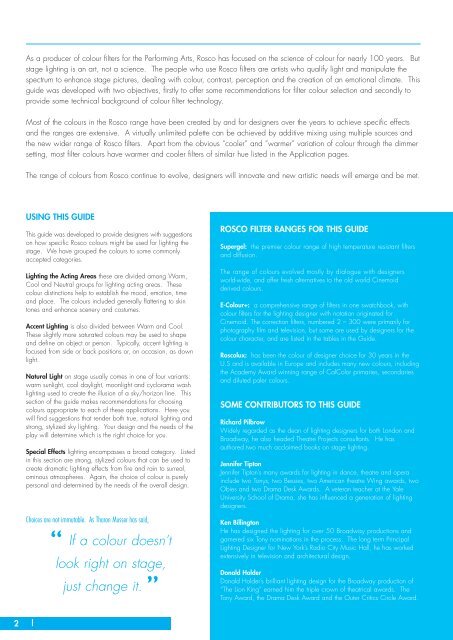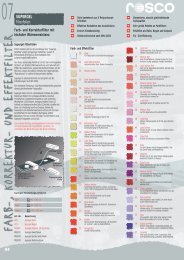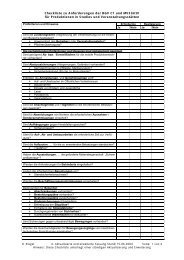Lighting the Acting Areas - AudioMaster
Lighting the Acting Areas - AudioMaster
Lighting the Acting Areas - AudioMaster
You also want an ePaper? Increase the reach of your titles
YUMPU automatically turns print PDFs into web optimized ePapers that Google loves.
2<br />
As a producer of colour filters for <strong>the</strong> Performing Arts, Rosco has focused on <strong>the</strong> science of colour for nearly 100 years. But<br />
stage lighting is an art, not a science. The people who use Rosco filters are artists who qualify light and manipulate <strong>the</strong><br />
spectrum to enhance stage pictures, dealing with colour, contrast, perception and <strong>the</strong> creation of an emotional climate. This<br />
guide was developed with two objectives, firstly to offer some recommendations for filter colour selection and secondly to<br />
provide some technical background of colour filter technology.<br />
Most of <strong>the</strong> colours in <strong>the</strong> Rosco range have been created by and for designers over <strong>the</strong> years to achieve specific effects<br />
and <strong>the</strong> ranges are extensive. A virtually unlimited palette can be achieved by additive mixing using multiple sources and<br />
<strong>the</strong> new wider range of Rosco filters. Apart from <strong>the</strong> obvious “cooler” and “warmer” variation of colour through <strong>the</strong> dimmer<br />
setting, most filter colours have warmer and cooler filters of similar hue listed in <strong>the</strong> Application pages.<br />
The range of colours from Rosco continue to evolve, designers will innovate and new artistic needs will emerge and be met.<br />
USING THIS GUIDE<br />
This guide was developed to provide designers with suggestions<br />
on how specific Rosco colours might be used for lighting <strong>the</strong><br />
stage. We have grouped <strong>the</strong> colours to some commonly<br />
accepted categories.<br />
<strong>Lighting</strong> <strong>the</strong> <strong>Acting</strong> <strong>Areas</strong> <strong>the</strong>se are divided among Warm,<br />
Cool and Neutral groups for lighting acting areas. These<br />
colour distinctions help to establish <strong>the</strong> mood, emotion, time<br />
and place. The colours included generally flattering to skin<br />
tones and enhance scenery and costumes.<br />
Accent <strong>Lighting</strong> is also divided between Warm and Cool.<br />
These slightly more saturated colours may be used to shape<br />
and define an object or person. Typically, accent lighting is<br />
focused from side or back positions or, on occasion, as down<br />
light.<br />
Natural Light on stage usually comes in one of four variants:<br />
warm sunlight, cool daylight, moonlight and cyclorama wash<br />
lighting used to create <strong>the</strong> illusion of a sky/horizon line. This<br />
section of <strong>the</strong> guide makes recommendations for choosing<br />
colours appropriate to each of <strong>the</strong>se applications. Here you<br />
will find suggestions that render both true, natural lighting and<br />
strong, stylized sky lighting. Your design and <strong>the</strong> needs of <strong>the</strong><br />
play will determine which is <strong>the</strong> right choice for you.<br />
Special Effects lighting encompasses a broad category. Listed<br />
in this section are strong, stylized colours that can be used to<br />
create dramatic lighting effects from fire and rain to surreal,<br />
ominous atmospheres. Again, <strong>the</strong> choice of colour is purely<br />
personal and determined by <strong>the</strong> needs of <strong>the</strong> overall design.<br />
Choices are not immutable. As Tharon Musser has said,<br />
“ If a colour doesn’t<br />
look right on stage,<br />
just change it. ”<br />
|<br />
ROSCO FILTER RANGES FOR THIS GUIDE<br />
Supergel: <strong>the</strong> premier colour range of high temperature resistant filters<br />
and diffusion.<br />
The range of colours evolved mostly by dialogue with designers<br />
world-wide, and offer fresh alternatives to <strong>the</strong> old world Cinemoid<br />
derived colours.<br />
E-Colour+: a comprehensive range of filters in one swatchbook, with<br />
colour filters for <strong>the</strong> lighting designer with notation originated for<br />
Cinemoid. The correction filters, numbered 2 – 300 were primarily for<br />
photography film and television, but some are used by designers for <strong>the</strong><br />
colour character, and are listed in <strong>the</strong> tables in <strong>the</strong> Guide.<br />
Roscolux: has been <strong>the</strong> colour of designer choice for 30 years in <strong>the</strong><br />
U.S and is available in Europe and includes many new colours, including<br />
<strong>the</strong> Academy Award winning range of CalColor primaries, secondaries<br />
and diluted paler colours.<br />
SOME CONTRIBUTORS TO THIS GUIDE<br />
Richard Pilbrow<br />
Widely regarded as <strong>the</strong> dean of lighting designers for both London and<br />
Broadway, he also headed Theatre Projects consultants. He has<br />
authored two much acclaimed books on stage lighting.<br />
Jennifer Tipton<br />
Jennifer Tipton’s many awards for lighting in dance, <strong>the</strong>atre and opera<br />
include two Tonys, two Bessies, two American <strong>the</strong>atre Wing awards, two<br />
Obies and two Drama Desk Awards. A veteran teacher at <strong>the</strong> Yale<br />
University School of Drama, she has influenced a generation of lighting<br />
designers.<br />
Ken Billington<br />
He has designed <strong>the</strong> lighting for over 50 Broadway productions and<br />
garnered six Tony nominations in <strong>the</strong> process. The long term Principal<br />
<strong>Lighting</strong> Designer for New York’s Radio City Music Hall, he has worked<br />
extensively in television and architectural design.<br />
Donald Holder<br />
Donald Holder’s brilliant lighting design for <strong>the</strong> Broadway production of<br />
“The Lion King” earned him <strong>the</strong> triple crown of <strong>the</strong>atrical awards. The<br />
Tony Award, <strong>the</strong> Drama Desk Award and <strong>the</strong> Outer Critics Circle Award.






